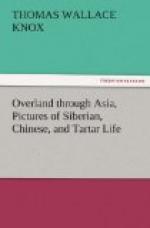On the 11th of October the weather was like summer, the air still and clear and my thermometer standing at 71 degrees. During the night I found it necessary to take an extra blanket, and at noon of the 12th the thermometer was at 45 deg., with a cloudy sky and a breeze from the northeast. This change of twenty-six degrees was too much for comfort, but of little consequence compared to my subsequent experience. Instances have been known of a change of seventy degrees in twelve hours from a sudden shifting of the wind. On the morning of the 13th we had a light fall of snow, with the air at freezing point and the water at 40 deg.[D]
[Footnote D: I here enter a protest against the Fahrenheit thermometer, and think all who have used it to any extent will join me in preferring the Centigrade or Reaumer scales. Centigrade has the freezing point at zero and the boiling point at 100 deg. Reaumer freezes at zero and boils at 80 deg. Fahrenheit very clumsily freezes at 32 deg. and boils at 212 deg. The difference in the graduation of the scale is of much less consequence than the awkwardness of beginning the reading at 32 deg. The Russians use Reaumer’s method, and I always envied them their convenience of saying ‘there are so many degrees of cold,’ or ’so many of heat,’ while I was forced to count from 32 deg. to use my national scale.]
We passed a rock projecting far into the river, with precipitous sides and a sharp summit visible for some distance along the Amoor. Below it is a small harbor, where the Russian steamer Mala Nadeshda (Little Hope) passed the winter of 1855. She was on her way to Stratensk, carrying Admiral Puchachin on his return from a mission to Japan. Caught by ice the Nadeshda wintered under shelter of this rock, while the Admiral became a horse marine and mounted a saddle for a ride of four hundred miles. Since that time the rock has borne the name of the boat it protected.
In most of the villages there are schools for educating the boys of the Cossacks and peasants. Some pupils are admitted free, while from others a small fee is required. Occasionally I saw boys flocking to the schools at sound of the master’s bell, or coming out at recess or dismissal. I had no opportunity to inspect one of these establishments, but presume my description of the one at Mihalofski will answer for all. The youths were as noisy as school-boys everywhere, and when out of restraint indulged in the same hilarity as if born on the banks of the Hudson or the Thames.
At noon on the 14th we stopped at Albazin to leave passengers and take wood. It was Sunday, and the population appeared in its best clothing, a few of the women sporting crinoline, and all wearing their best calicoes. Among the men there were Cossacks and soldiers in their grey coats or in plain cloth and sheepskin. I saw a few Yakuts with the narrow eyes of the Tunguze and their clothing of deerskin.
A few Orochons stood apart from the Russians, but not less observant of the boat and those on board. Outside the village were three or four conical yourts belonging to the aboriginals. It is said this people formerly lived in the province of Yakutsk, whence they emigrated to the Amoor in 1825. One of their chiefs has a hunting knife with the initials of the Empress Catherine. It was presented to an ancestor of the present owner.




